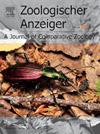低于预期:阿根廷中北部毛线蛛物种群(啮齿目,毛线蛛科)的物种多样性
IF 1.5
3区 生物学
Q2 ZOOLOGY
引用次数: 0
摘要
蛇属是哺乳动物中种类最丰富的属之一。随着新的数据和分析工具的出现,其物种分类也在不断修订中。综合方法为整合形态学、遗传学和生物地理学标准提供了一个有价值的框架,有助于澄清模棱两可的物种边界。本研究采用综合方法评价了分布在阿根廷中北部的Ctenomys属Mendocinus群的一些名义形式:Ctenomys bergi, Ctenomys bonettoi, Ctenomys rionegrensis和C.“yolandae”之间的系统发育关系。从形态学角度,颅牙测量比较使用描述性统计和多元统计分析。从遗传学的角度,利用线粒体细胞色素b基因的完整序列重建了贝叶斯和最大似然系统发育树。结果表明,C. bonettoi和C.“yolandae”在遗传和形态上与C. bergi难以区分,因此应与后者同义。此外,研究还发现,在遗传和形态上,黄颡鱼和贝氏锦鲤之间的差异很小;甚至低于门多西努斯群的种间值。这两个物种之间的遗传差异可能与南美第二大河流——帕拉纳河有关。本研究结果可能对所研究分类群的保护状况评估有重要影响,因为它们大大扩大了同义种的分布范围。本文章由计算机程序翻译,如有差异,请以英文原文为准。
Less than expected: species diversity of the Ctenomys mendocinus species group (Rodentia, Ctenomyidae) in north–central Argentina
The genus Ctenomys is one of the most species-rich genera among mammals. The taxonomy of its species is under constant revision as new data and analytical tools become available. Integrative approaches provide a valuable framework for incorporating morphological, genetic, and biogeographic criteria, helping to clarify ambiguous species boundaries. This study uses an integrative approach to evaluate the phylogenetic relationships among some nominal forms of the Mendocinus group of the genus Ctenomys, distributed in north–central Argentina: Ctenomys bergi, Ctenomys bonettoi, Ctenomys rionegrensis and C. “yolandae”. From a morphological perspective, craniodental measurements were compared using descriptive statistics and multivariate statistical analyses. From a genetic perspective, Bayesian and Maximum Likelihood phylogenetic trees were reconstructed using complete sequences of the mitochondrial cytochrome b gene. Our results showed that both C. bonettoi and C. “yolandae” are genetically and morphologically indistinguishable from C. bergi and should therefore be synonymized with the latter. Additionally, it was found that the genetic and morphological divergence between C. rionegrensis and C. bergi is considerably low; even below the interspecific values for the Mendocinus group. The genetic divergence between the two species could be related to the Paraná River, the second largest river in South America. The results of this study may have a significant impact on the conservation status assessment of the taxa under study, as they considerably expand the distribution range of the synonymized species.
求助全文
通过发布文献求助,成功后即可免费获取论文全文。
去求助
来源期刊

Zoologischer Anzeiger
生物-动物学
CiteScore
2.80
自引率
7.10%
发文量
75
审稿时长
>12 weeks
期刊介绍:
Zoologischer Anzeiger - A Journal of Comparative Zoology is devoted to comparative zoology with a special emphasis on morphology, systematics, biogeography, and evolutionary biology targeting all metazoans, both modern and extinct. We also consider taxonomic submissions addressing a broader systematic and/or evolutionary context. The overall aim of the journal is to contribute to our understanding of the organismic world from an evolutionary perspective.
The journal Zoologischer Anzeiger invites suggestions for special issues. Interested parties may contact one of the editors.
 求助内容:
求助内容: 应助结果提醒方式:
应助结果提醒方式:


